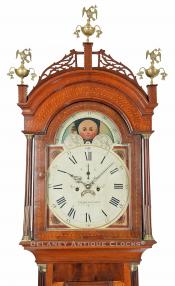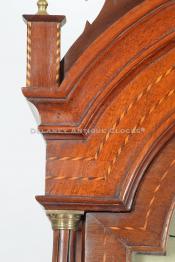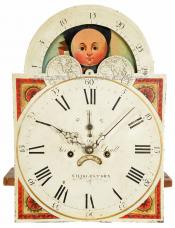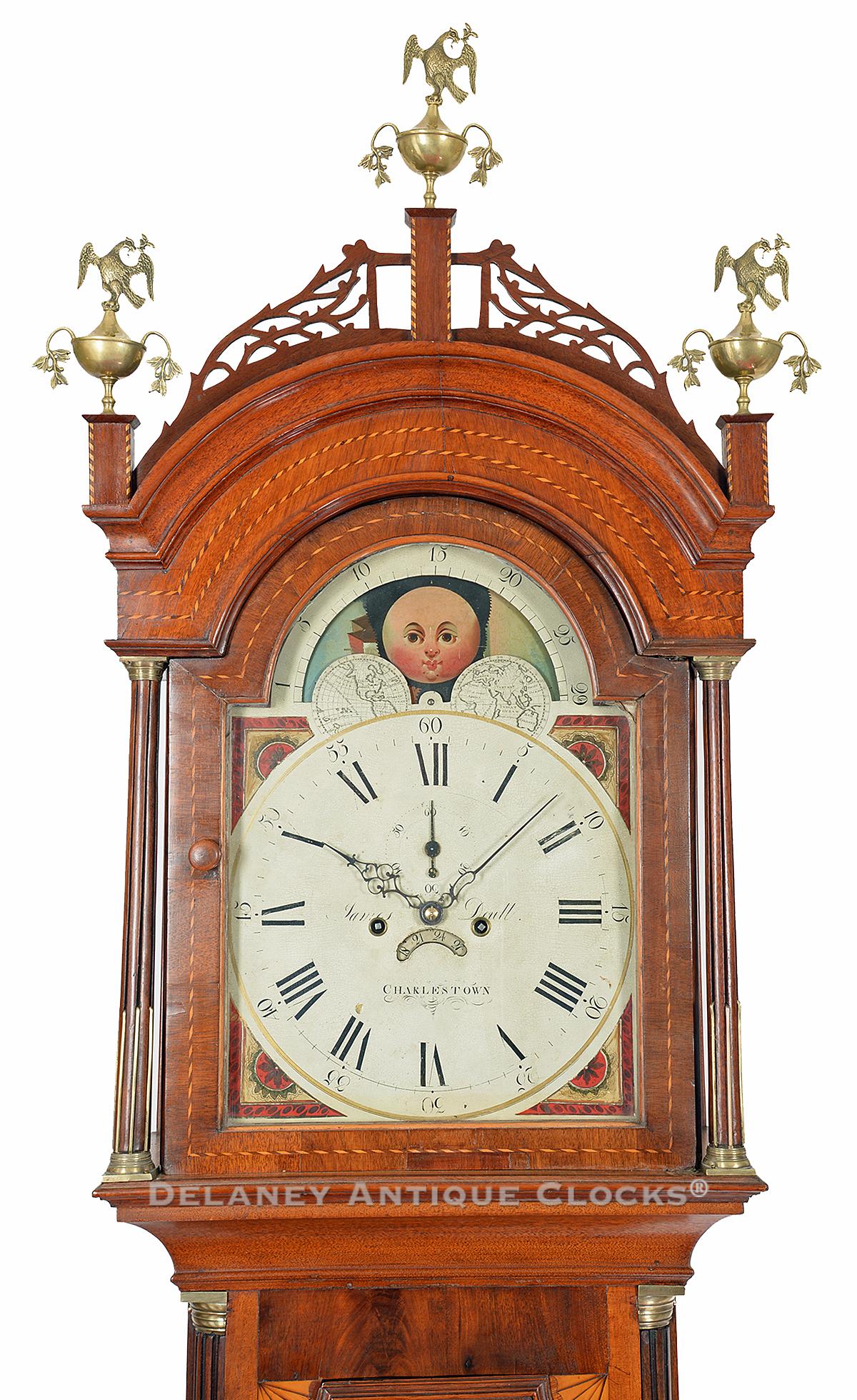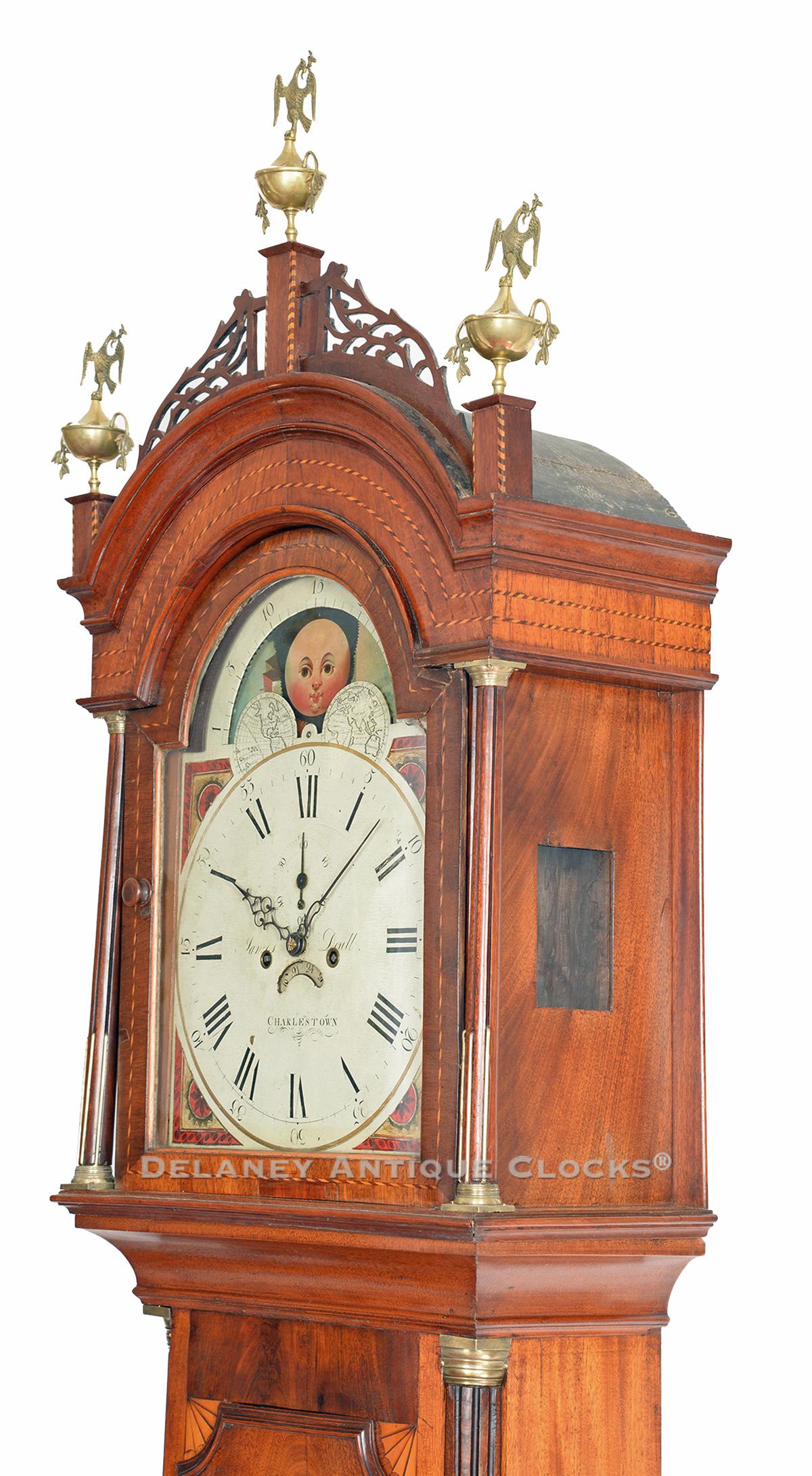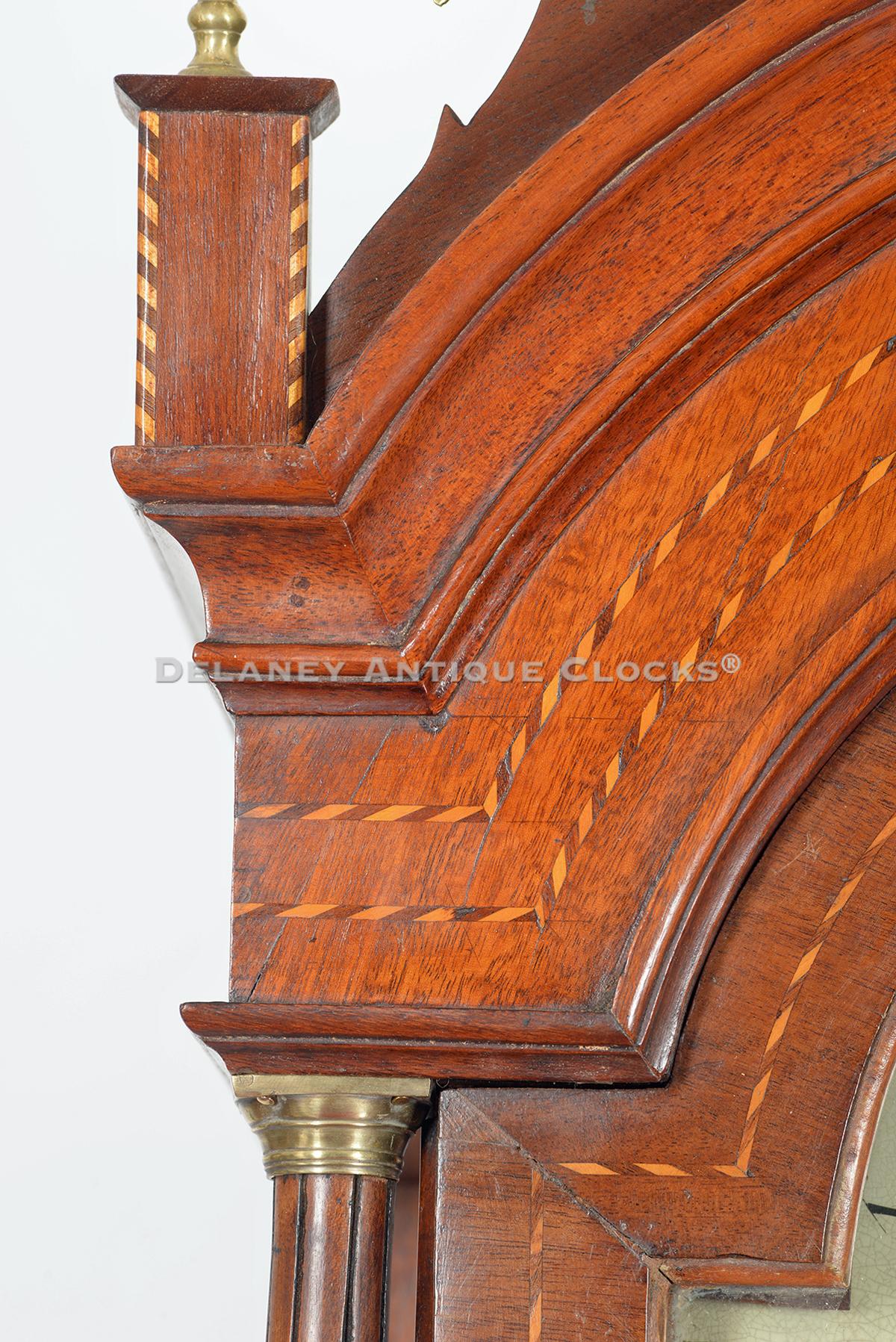James Doull of Charlestown, Massachusetts. An inlaid mahogany tall case clock. Case attributed to the Stephen Badlam school of cabinetmaking. 216031.
This is an important Hepplewhite tall case clock with a painted dial signed by the Charlestown, Massachusetts clockmaker, James Doull. This inlaid mahogany case is attributed to the Dorchester school of cabinetmakers, of which Stephen Badlam is the master.
This example features a colorfully painted 13-inch iron dial. This dial is of local origin and was most likely painted by the Boston artists Spencer Nolen & Samuel Curtis. Similar dials have been found to date with their signature signed on the back. This example is signed by the clockmaker, "James Doull," in script lettering across the center of the dial. His working location, "CHARLESTOWN," is written in block lettering and is positioned below the calendar. In the dial arch, one will find the automated feature of a lunar calendar or a moon phase mechanism. This is designed to track the phases of the moon. The lunar calendar is approximately 29.5 days. Between the moons that oppose each other are two additional painted scenes. The first is nautical in that it depicts a sailboat out at sea. The second scene is a view of the coast. A tower is the most prominent feature. It may be a lighthouse of some form. The four spandrel areas or corners of the dial are decorated with colorfully geometric patterns. The use of red and yellow contrast nicely and attract one's attention. The hours are indicated by large Roman numerals. An Arabic style is used for the five-minute markers. A subsidiary seconds dial and a calendar are displayed in the traditional locations. The hands are nicely formed and filed from steel.
This fine movement is constructed in brass and is of good quality. Four turned pillars support the two brass plates. Hardened steel shafts support the polished steel pinions and brass gearing. The winding drums are grooved. The escapement is designed as a recoil format. The movement is weight driven and designed to run for eight days on a full wind. It is a two-train or a time and strike design having a rack and snail striking system. As a result, it will strike each hour on the hour. This is done on a cast iron bell which is mounted above the movement. The strike hammer is returned to the ready position via a coil spring. This clock retains its original tin can weights and pendulum.
This very impressive inlaid mahogany case is attributed to the Stephen Badlam(1751-1815) school cabinetmakers who were working in Dorchester, Massachusetts, and made a number of cases for the Willards and their contemporaries. It is the inlay patterns and the complexity throughout the construction of this case that this attribution is based. Fortunately, a number of these cases are identified by his practice of stamping his initials or the initials of one of his apprentices inside the case. The Willard House and Clock Museum, located in North Grafton, Massachusetts, has three clocks of this general type in its collection. All of these are illustrated in "THE WILLARD HOUSE AND CLOCK MUSEUM and The Willard Family Clockmakers," which was written by Dr. Roger Robinson & Herschel Burt. The most impressive example houses a musical works constructed by Simon Willard. A second signed example features a painted dial signed by Aaron Willard.
This example exhibits excellent masculine proportions in order to accommodate the 13-inch dial. The base proudly stands on four applied ogee bracket feet. A double-step molding transitions this component to the structure of the case. The base panel is veneered with many highly figured mahogany selections. They are framed with a number of interesting design elements. The first is the use of a barber pole line inlay that frames the perimeter of the panel. Next is a cross-banded framing that is an inch and three-quarters wide. Additional barber pole inlays define the interior edge of the cross-banding. Four large fans are positioned in each corner. Each is constructed with six petals and capped at the ends. The next section of cross-banding follows the shape of the fans. This is a complicated design and is difficult to construct. The center panel was selected for its crotch grain pattern. It is tightly formed and centered in the panel. The waist section is long, and it is fitted with a large rectangular-shaped waist door that is trimmed with applied molding and veneered with a selection of mahogany that is interesting. This door is unusual in that the corners are cut out or relieved. The decorative element of four of the additional five petal quarter fans is incorporated in the door frame, not in the door. This is a very interesting feature and is often associated with the Badlam school. The door provides access to the interior of the case, where one will find a brass-covered pendulum bob and two red-painted tin can weights. The sides of the case are fitted with brass stopped quarter columns. These terminate in brass quarter capitals. They are elevated on mahogany blocks that are trimmed on the outer edge with additional barber pole line inlays. The bonnet design is complex. It features an open fretwork design that is supported by three inlaid finial plinths. The inlay pattern is a barber pole design, and the plinths are capped. Each supports a brass finial. The basic form is an urn. A phoenix with its wings outstretched sits atop the urns in a dramatic pose. Oak leaves drape off of the urns below the center mass. This is all atop a double-arched hood. The broad frieze that separates the two arches is line inlaid. This inlay pattern continues around the corners and across the sides of the case. In other Badlam examples, the frontal area is often decorated with blind frets. This inlay design is a nice departure from the norm. The arched bonnet door is also lined inlaid, and the opening is fitted with glass. Fully turned and brass stop fluted bonnet columns support the upper bonnet molding. Rectangular windows are fitted into the sides of the case.
This wonderful clock was made circa 1810 and stands approximately 100" tall.
This clock is inventory number 216031.
James Doull was born in Scotland in 1785 and immigrated to the United States, Boston, in 1806 at the age of 29. In 1807, he was listed in the Boston tax records as working as a journeyman working for the Boston clockmaker Aaron Willard. This suggests that he came to this country already trained and highly skilled. Because he is listed for only one year in Boston, it is assumed he moved to Charlestown shortly after this date. In 1823, Doull moved to Pennsylvania and took up residence in Philadelphia. In this city, he is listed as having several addresses over the years. In 1823, he resided at 112 High. In 1825, Doull moved to No. 3 Castle. From 1828 through 1833, he was on the southeast corner of South and Spruce. From 1835 through 1849, he was at the southeast corner of 4th and Spruce. Lastly, in 1856, Doull moved to south 4th and stayed there until 1856.
Over the years, we have owned a dozen or more tall case clocks, several shelf clocks, and a small number of timepieces made by this fine and talented clockmaker. The vast majority of the known clocks to us were of Massachusetts origin. One tall clock with the place location signed "Philadelphia" is also known. James Doull's most famous clock is in the White House Collection in Washington, DC. This clock is frequently on display in the Oval Office. It features a signed painted dial and a case that is attributed to the Seymour Brothers cabinetmaking firm.


